2012 Sea Turtle Workshop a Success!

Sea turtle biologists from all over the world gather around a loggerhead sea turtle prior to its necropsy. Photographic measurements and detailed documentation are essential throughout the necropsy process.
The Turtle Hospital and sea turtle professionals from around the globe kicked off the start of December with a weekend dedicated solely to sea turtles. For the 20th year, The Turtle Hospital hosted the annual Florida Keys Sea Turtle Workshop, spanning December 2-4. Representatives from sea turtle conservation organizations in the fields of research, rehabilitation and education came together to share knowledge gleaned over the past year regarding these ancient creatures.
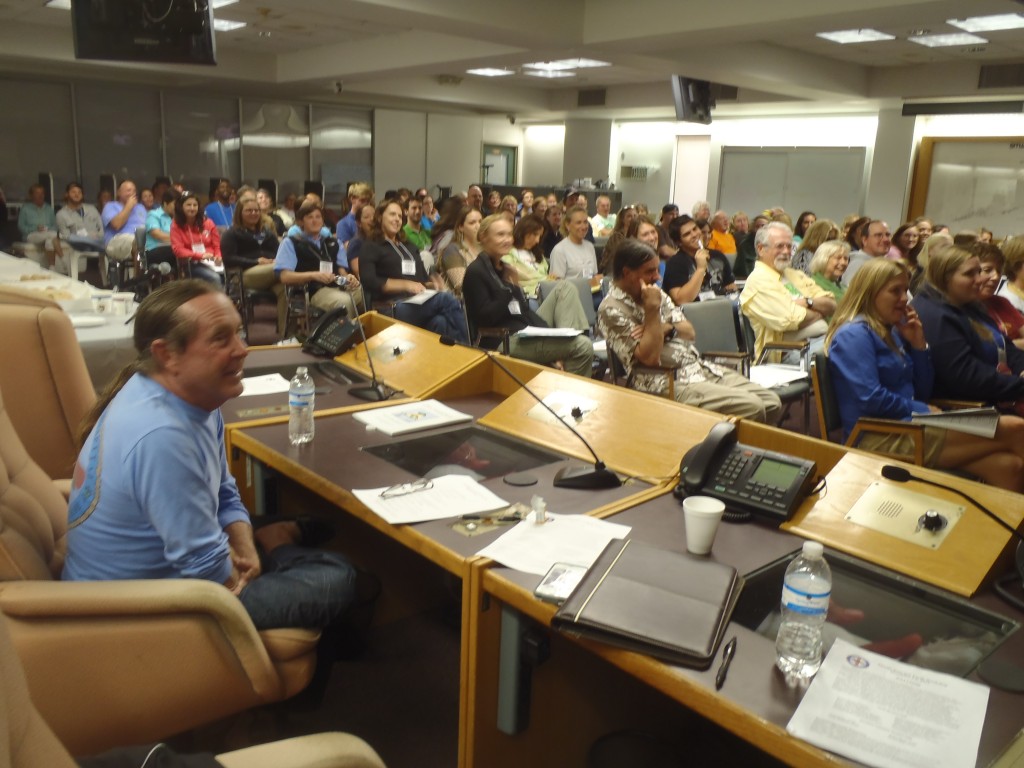
Gathering at the Marathon Government Center on Saturday, 119 registrants for the workshop listened to presentations from colleagues in the field of sea turtle conservation. Founder Richie Moretti, pictured in the left foreground, has been putting on the event for 20 years!
Reconnecting with colleagues, numerous groups were represented during a day-long symposium filled with detailed presentations and discussions spanning all realms of the conservation field. Information covered topics such as wound care, sea turtle therapy, nutrition, fibropapilloma and anemia case studies, hatchling care, PIT tagging, anatomy, blood chemistry, interesting patient cases, anthropogenic injuries and distance learning. The Turtle Hospital was represented by our very own veterinarian, Dr. Doug Mader, and Rehabilitation Specialists Stacey Venzel and Marie Simpson who individually took the podium to share work in their profession over the past year. Other organizations that presented included NOAA, FWC, Florida Atlantic University, Georgia Sea Turtle Center, Mote Marine Laboratory, University of Florida, Miami Seaquarium, Gumbo Limbo, WIDECAST, South Carolina Aquarium, Marathon Veterinary Hospital and University of Georgia’s College of Veterinary Medicine.
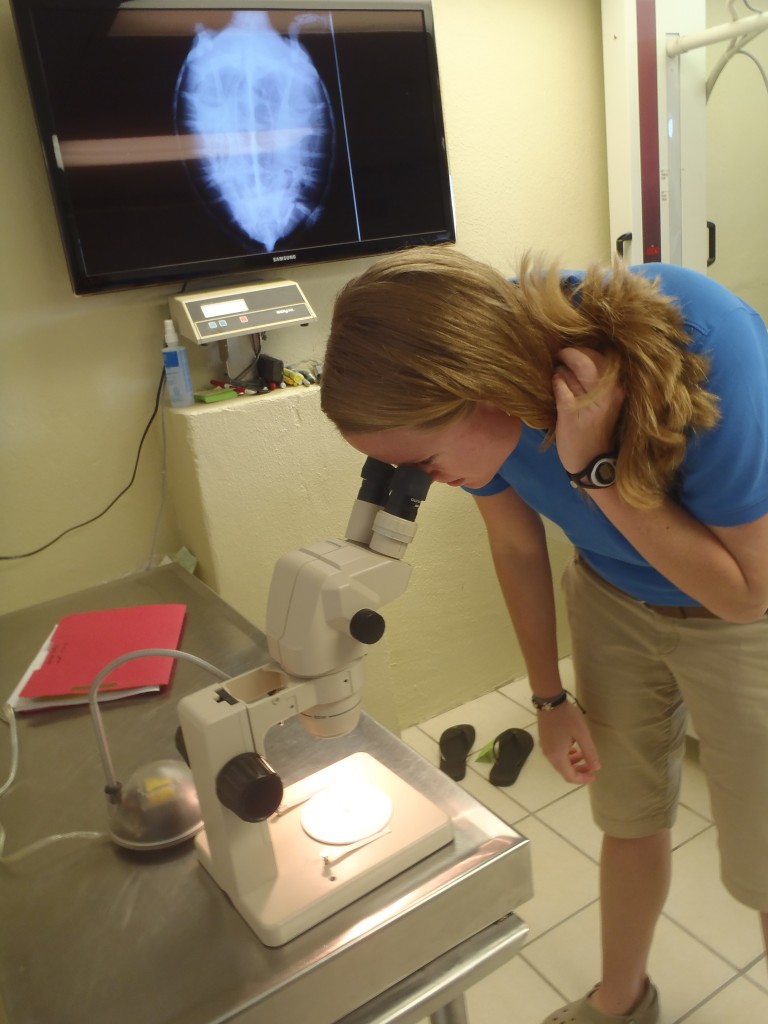
The Turtle Hospital Education Specialist Teresa Ryan observes a parasite sample under a stereoscope. The entire Turtle Hospital staff put in long hours–before, during and after!–to pull this event together, and it all paid off!
The 119 participants in the weekend’s successful event came from all over the state of Florida as well as up and down the U.S. east coast. Fellow sea turtle enthusiasts even made the long trip from far away places like Hawaii, the U.S. Virgin Islands, Venezuela and the small island of Bonaire.
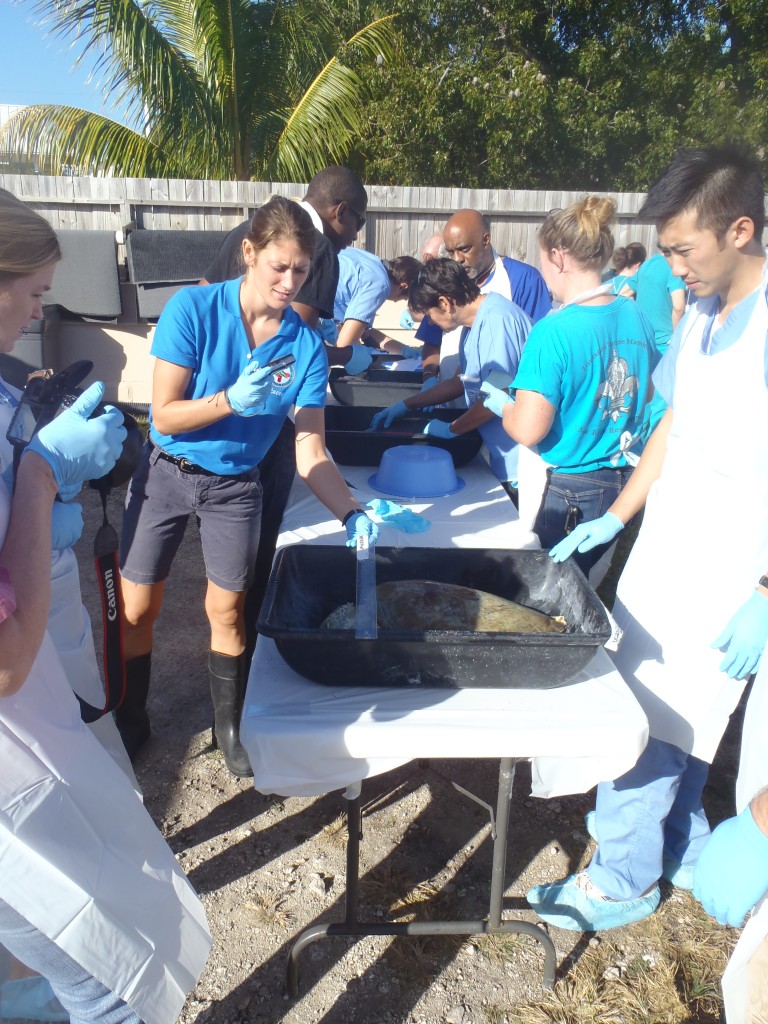
Rehabilitation Specialist Stacey Venzel of The Turtle Hospital leans in to make photographic documentation of a DOA green sea turtle during the necropsy lab. An interesting parasite was collected from the turtle’s GI tract for further diagnosis.
A silent auction was held throughout the day on Saturday to raise money for WIDECAST–the Wider Caribbean Sea Turtle Network. Items were donated by the many conservation organizations present at the event. Total earnings reached approximately $1,500–all going directly back to sea turtle conservation!
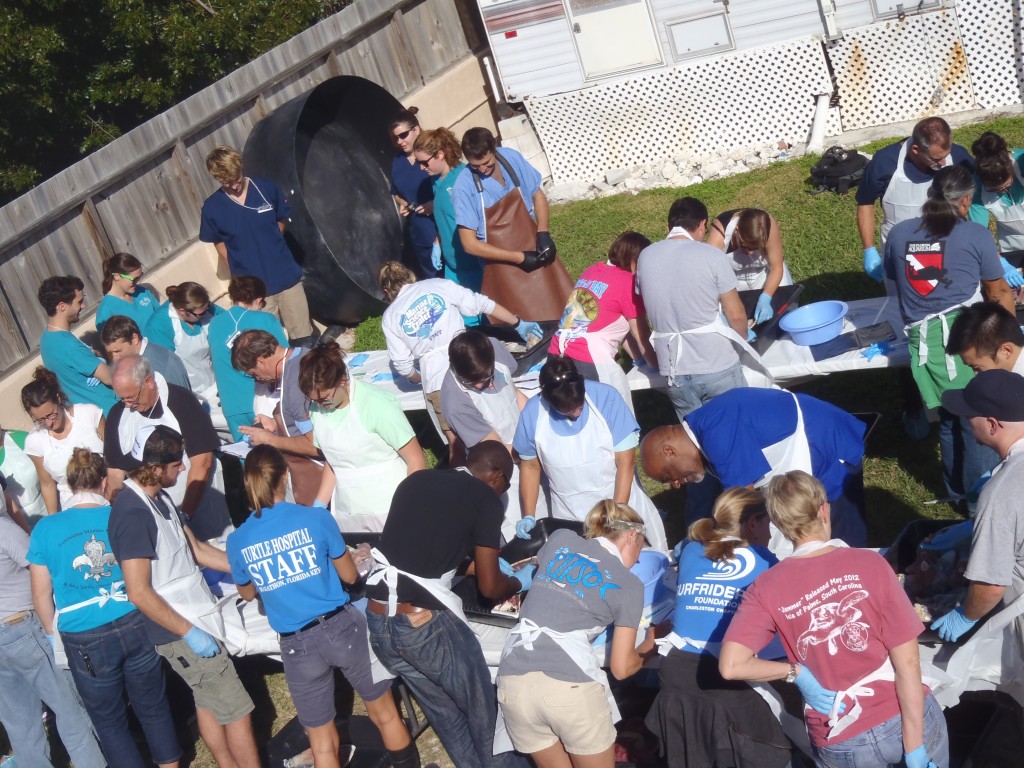
Sea turtle scientists get down and dirty during the necropsy lab led by Dr. Brian Stacy. Special thanks to Dr. Doug Mader and Tom Luebke of The Turtle Hospital and Dr. Terry Norton of GSTC for advisory assistance during the 3-hour lab.
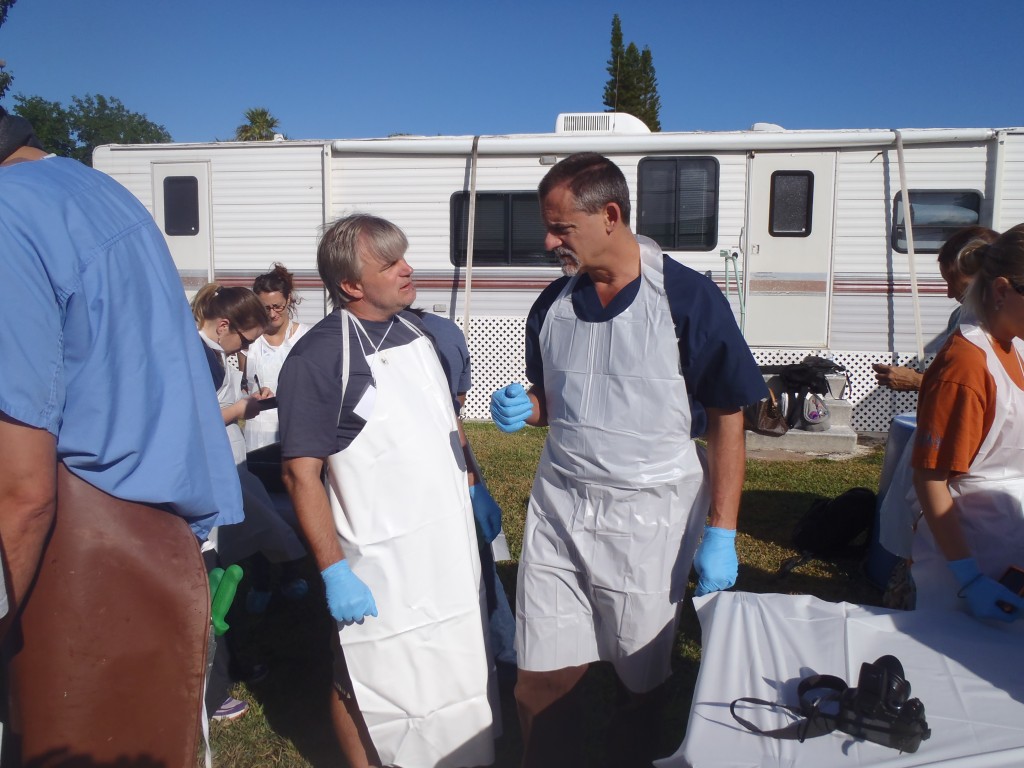
Turtle Hospital veterinarian Dr. Doug Mader, right, provided expert assistance during the necropsy lab. Dr. Mader also presented at the conference on “Sea Turtle Wound Care.”
The final day of the workshop consisted of two labs–a “wet” and a “dry” lab. Dr. Brian Stacy of the University of Florida led a hands-on necropsy lab, with Dr. Doug Mader assisting. He began with an overview of necropsy techniques which was followed up by attendees teaming together to necropsy individual turtles. A total of 10 sea turtle necropsies were performed on Sunday over a span of 3 hours. An interesting and yet unidentified parasite was found in the GI tract of a DOA juvenile green. Samples were kept at The Turtle Hospital as well as sent back to UF with Dr. Stacy. One juvenile green was riddled with internal fibropapilloma tumors as small as marbles and as large as oranges! For many turtles, the cause of death was determined to be aspiration, while other CODs were linked to emaciation. Necropsies allow professionals to quantify the human versus natural causes of death for wildlife, as well as to better understand the anatomy of these amazing, mystifying creatures.
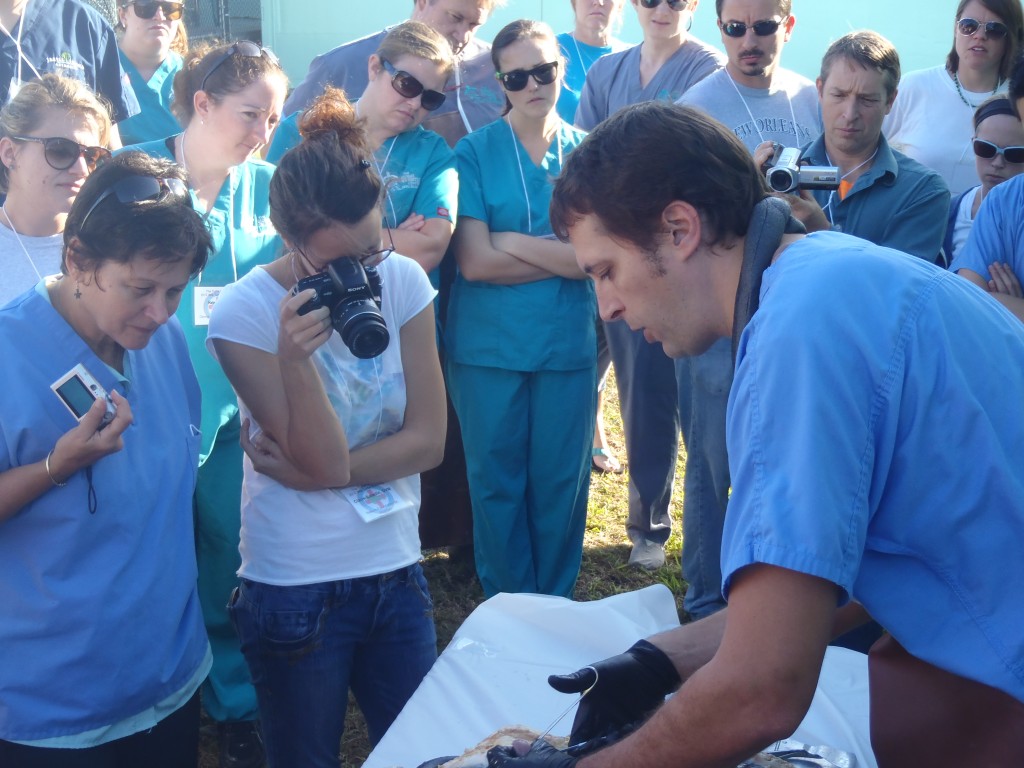
Dr. Brian Stacy of UF and NOAA gives an overview of necropsy technique at the start of the “wet” lab. Dr. Stacy also presented at Saturday’s symposium with a lecture entitled “Watercraft Injuries: Forensic Science and Sea Turtle Conservation.”
The “dry” lab was led by Dr. Jeanette Wyneken of FAU. A renowned expert on sea turtle anatomy, Dr. Wyneken’s lecture introduced novice and advanced participants to the inner workings of sea turtles. She also discussed surgery methods in sea turtles. A printable copy of Dr. Wyneken’s sea turtle anatomy book is even available free of charge online.
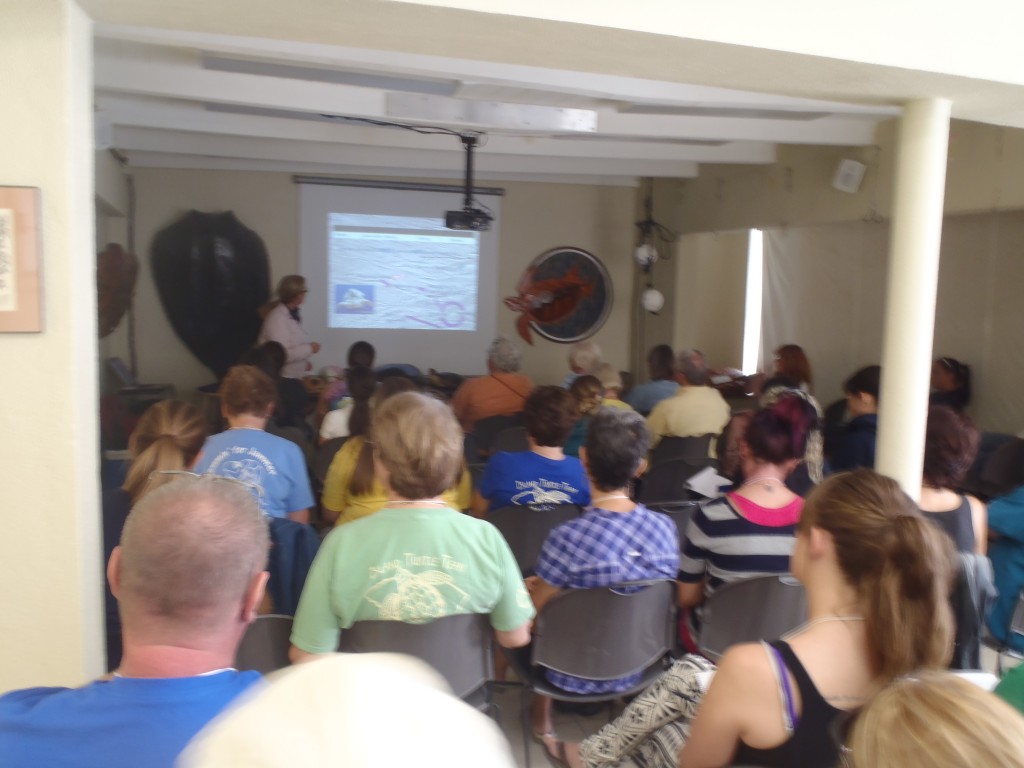
Dr. Jeanette Wyneken shares knowledge of sea turtle anatomy and surgery during a lecture on Sunday. Dr. Wyneken also presented at the symposium with a presentation entitled “What Does The Nose Know?”
Wrapping up the conference, The Turtle Hospital and the weekend’s attendees were exceptionally pleased with the caliber of presentations, labs and comaraderie. A special thanks fo Save-a-Turtle for once again sponsoring a BBQ, reminding us that it’s not all work–scientists get to have fun, too!
The 2012 Florida Keys Sea Turtle Workshop would not have been possible without our dedicated staff, each of which put in more than 40 hours on the clock, plus additional hours of volunteering. Thank you to our staff:
Richie Moretti, Director (and “Turtle Man” for 27 years)
Bette Zirkelbach, Manager (and organizer of all things great and small)
Tom Luebke, Engineer (and pizza, juice and bagel man)
Dr. Doug Mader, Veterinarian (and reptile expert)
Donna Wilson, Gift Shop Manager (and go-to-lady for a good place to eat)
Barbara Meyer, Education Specialist (and sea turtle jewelry model)
Teresa Ryan, Education Specialist (and jack-of-all-trades)
Elisabeth Miska, Education Specialist (and after hour tour guide)
Rachel Harrington, Education Specialist (and after hour tour guide sidekick)
Marie Simpson, Rehab Specialist (and Save-a-Turtle’s sea turtle hoodie artist)
Stacey Venzel, Rehab Specialist (and photographer donning rubber boots)
Matt Brochhausen, Rehab Specialist (and rapid fire tank cleaner)
Jim Weidman, Rehab Specialist (and extra hand at all hours–even the wee hours)
Bruce Squier, Maintenance (and power-wash extraordinaire)
Lisa Brooks, Education Specialist (and last minute savior)
Thank you for your continued efforts to save sea turtles!
Comments are closed.


